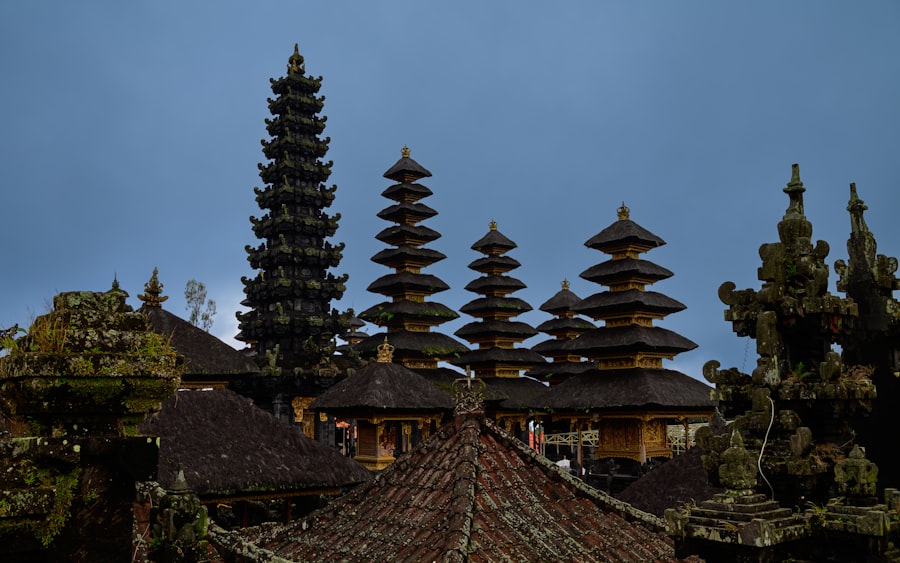Preserving the Banaue Rice Terraces: A Cultural Heritage
Description
The Banaue Rice Terraces, often referred to as the “Eighth Wonder of the World,” are a breathtaking testament to the ingenuity and resilience of the Ifugao people in the Philippines. Carved into the mountains over 2,000 years ago, these terraces stretch across the landscape like a green staircase, showcasing an intricate system of irrigation that has been passed down through generations. The terraces are not merely agricultural fields; they represent a harmonious relationship between the Ifugao culture and their environment.
This ancient agricultural practice is deeply intertwined with the spiritual beliefs and traditions of the Ifugao people, who view the rice terraces as a sacred gift from their ancestors. The construction of the rice terraces is a remarkable feat of engineering, demonstrating advanced knowledge of hydrology and agriculture. The Ifugao utilized simple tools and techniques to create a sustainable farming system that maximizes land use while minimizing soil erosion.
The terraces are built with stone walls that hold back water and soil, allowing rice to be cultivated on steep slopes that would otherwise be unproductive. This method not only supports food security for the local population but also preserves biodiversity in the region. The terraces are a living cultural landscape, where traditional farming practices continue to thrive alongside modern influences, making them a unique symbol of cultural heritage.
Key Takeaways
- The Banaue Rice Terraces are a cultural wonder and a UNESCO World Heritage site, showcasing the ingenuity and agricultural knowledge of the Ifugao people.
- Preserving the Banaue Rice Terraces is crucial for maintaining the cultural heritage of the Ifugao people and ensuring sustainable agricultural practices.
- Threats to the Banaue Rice Terraces include environmental degradation, population decline in farming communities, and the impact of modernization on traditional farming practices.
- Efforts to preserve the Banaue Rice Terraces include conservation projects, sustainable farming initiatives, and community-based tourism programs.
- Indigenous communities play a vital role in preserving the Banaue Rice Terraces through traditional knowledge, cultural practices, and active participation in conservation efforts.
- Eco-tourism and sustainable development in the Banaue Rice Terraces can provide economic opportunities for local communities while promoting environmental conservation and cultural preservation.
- The global significance of the Banaue Rice Terraces lies in its cultural and historical value, serving as a symbol of sustainable land use and traditional farming practices.
- Individuals can contribute to preserving the Banaue Rice Terraces by supporting local initiatives, practicing responsible tourism, and raising awareness about the importance of cultural and environmental conservation.
The Importance of Preserving the Banaue Rice Terraces
Preserving the Banaue Rice Terraces is crucial for several reasons, not least of which is their cultural significance. As a UNESCO World Heritage Site, the terraces embody the rich history and traditions of the Ifugao people. They serve as a living museum, showcasing ancient agricultural practices that have sustained communities for centuries.
The terraces are not just fields; they are a reflection of the Ifugao identity, encapsulating their values, beliefs, and way of life. Protecting this cultural heritage is essential for maintaining the community’s sense of identity and continuity in an ever-changing world. Moreover, the preservation of the rice terraces has significant ecological implications.
The terraces play a vital role in maintaining local biodiversity and preventing soil erosion in the mountainous regions of the Philippines. They provide habitat for various plant and animal species, contributing to the overall health of the ecosystem. By preserving these terraces, we also safeguard traditional agricultural practices that promote sustainable land use and environmental stewardship.
The terraces exemplify how indigenous knowledge can inform modern conservation efforts, highlighting the importance of integrating cultural heritage into environmental management strategies.
Threats to the Banaue Rice Terraces

Despite their cultural and ecological importance, the Banaue Rice Terraces face numerous threats that jeopardize their existence. One of the most pressing issues is climate change, which has led to unpredictable weather patterns, including prolonged droughts and intense rainfall. These changes disrupt traditional farming cycles and can cause significant damage to the terraces themselves. Increased rainfall can lead to landslides, while droughts can diminish rice yields, threatening food security for local communities.
In addition to climate change, modernization poses a significant threat to the rice terraces. As younger generations migrate to urban areas in search of better opportunities, traditional farming practices are being abandoned. This shift not only diminishes the labor force needed to maintain the terraces but also erodes cultural knowledge related to rice cultivation.
Furthermore, infrastructure development, such as road construction and tourism facilities, can encroach upon terrace lands, leading to further degradation of this cultural landscape. The combination of these factors creates a precarious situation for the future of the Banaue Rice Terraces.
Efforts to Preserve the Banaue Rice Terraces
| Effort | Metrics |
|---|---|
| Community Engagement | Number of local community members involved in preservation activities |
| Conservation Projects | Area of land restored or protected |
| Tourism Management | Number of visitors educated about the terraces’ significance |
| Government Support | Amount of funding allocated for preservation efforts |
Recognizing the urgent need for preservation, various initiatives have been launched to protect and restore the Banaue Rice Terraces. Local government units, non-governmental organizations (NGOs), and international bodies have collaborated on projects aimed at revitalizing traditional farming practices and promoting sustainable land management. These efforts often include training programs for farmers that emphasize organic farming techniques and sustainable irrigation methods.
By equipping local farmers with modern knowledge while respecting traditional practices, these initiatives aim to enhance productivity while preserving cultural heritage. Additionally, community-based tourism has emerged as a strategy for generating income while fostering awareness about the importance of preserving the rice terraces. By inviting visitors to experience the beauty and culture of the Ifugao people, local communities can benefit economically while simultaneously raising awareness about conservation efforts.
This approach encourages tourists to engage with local traditions and supports initiatives that prioritize environmental sustainability. Through these combined efforts, there is hope for revitalizing interest in terrace farming and ensuring that this cultural wonder continues to thrive for future generations.
The Role of Indigenous Communities in Preserving the Banaue Rice Terraces
Indigenous communities play a pivotal role in preserving the Banaue Rice Terraces, as they are the stewards of this cultural landscape. The Ifugao people possess invaluable knowledge about sustainable farming practices that have been honed over centuries. Their deep understanding of local ecosystems allows them to manage resources effectively while maintaining biodiversity.
This indigenous knowledge is crucial for adapting to contemporary challenges such as climate change and environmental degradation. Moreover, community engagement is essential for any preservation effort to be successful. The Ifugao people’s active participation in decision-making processes ensures that their voices are heard and their needs are met.
Initiatives that empower local communities to take charge of conservation efforts foster a sense of ownership and responsibility towards their cultural heritage. By involving indigenous communities in preservation strategies, we not only honor their traditions but also create a more sustainable future for the rice terraces.
Eco-Tourism and Sustainable Development in the Banaue Rice Terraces

Eco-tourism has emerged as a viable avenue for promoting sustainable development in the Banaue Rice Terraces region. By attracting visitors who are interested in experiencing authentic cultural practices and natural beauty, eco-tourism provides an economic incentive for local communities to preserve their heritage. Tourists can participate in guided tours that showcase traditional farming techniques, engage with local artisans, and enjoy breathtaking views of the terraces while contributing to conservation efforts.
However, it is essential that eco-tourism is managed responsibly to avoid negative impacts on both the environment and local culture. Sustainable tourism practices should prioritize minimizing ecological footprints, respecting local customs, and ensuring that economic benefits are equitably distributed among community members. By fostering a tourism model that emphasizes sustainability and cultural appreciation, eco-tourism can serve as a powerful tool for preserving the Banaue Rice Terraces while providing livelihoods for local residents.
The Global Significance of the Banaue Rice Terraces
The Banaue Rice Terraces hold global significance beyond their immediate cultural and ecological value. They serve as an example of how indigenous knowledge can inform sustainable agricultural practices worldwide. In an era marked by climate change and environmental degradation, lessons learned from the Ifugao people’s relationship with their land can inspire similar initiatives in other regions facing agricultural challenges.
The terraces exemplify resilience in agriculture through innovative land use strategies that harmonize with nature. Furthermore, as a UNESCO World Heritage Site, the rice terraces attract international attention and support for preservation efforts. Their recognition on a global platform underscores the importance of protecting cultural landscapes that embody human creativity and adaptation to environmental challenges.
This global significance fosters collaboration among nations in sharing best practices for conservation and sustainable development, highlighting how local actions can have far-reaching impacts on global sustainability goals.
How Individuals Can Contribute to Preserving the Banaue Rice Terraces
Individuals can play a vital role in preserving the Banaue Rice Terraces through various means, starting with responsible tourism practices. When visiting this cultural wonder, tourists should prioritize engaging with local communities respectfully and supporting businesses that promote sustainable practices. Choosing eco-friendly accommodations and participating in community-led tours can help ensure that tourism benefits local residents while minimizing environmental impacts.
Moreover, raising awareness about the importance of preserving cultural heritage can amplify efforts at both local and global levels. Sharing information about the rice terraces through social media platforms or community events can inspire others to appreciate and support preservation initiatives. Additionally, individuals can contribute financially by donating to organizations focused on conservation efforts or participating in volunteer programs aimed at restoring and maintaining the terraces.
By taking these steps, individuals can become advocates for preserving not only the Banaue Rice Terraces but also other cultural landscapes around the world that face similar threats.

Facebook comments